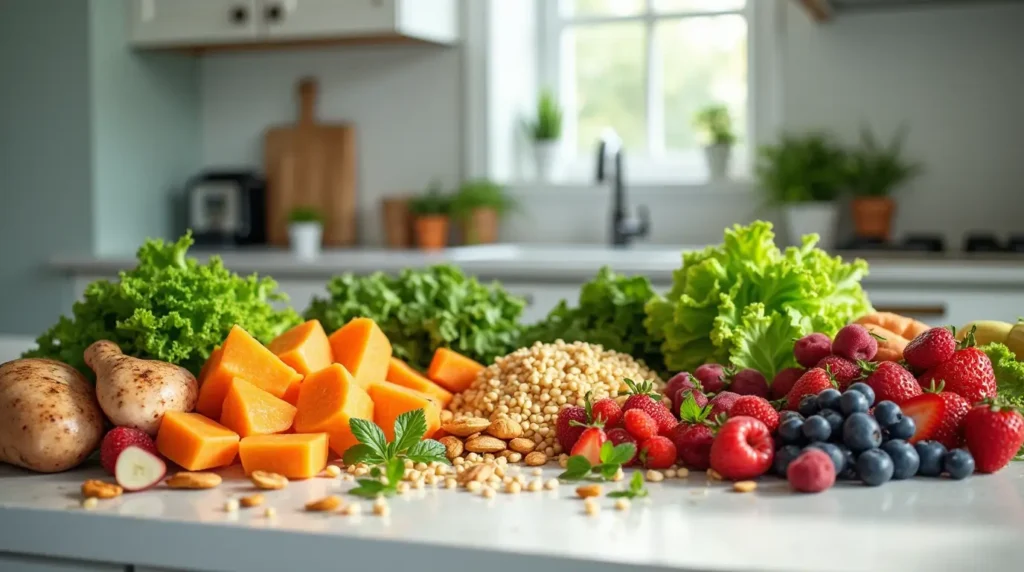How to Choose the Best Foods for Sustained Weight Loss Success
Table of Contents

Introduction
How to Choose the Best Foods, Have you ever wondered why some people seem to lose weight effortlessly while others struggle despite strict diets?
The secret may not be in cutting calories alone but in choosing the right foods that naturally boost fat burning, keep you full, and support long-term healthy habits. If you’re struggling to shed pounds, the best food for weight loss isn’t just about restriction—it’s about smart, satisfying choices that work with your body.
The key lies in selecting nutrient-dense, metabolism-boosting ingredients that help you burn fat, control cravings, and maintain energy. In this guide, we’ll explore the most effective foods for weight loss, how to prepare them, and the science behind why they work.
Ingredient List
Here’s a powerhouse selection of the best fat-burning, hunger-satisfying foods:
- Lean Proteins: Chicken breast, turkey, tofu, eggs, Greek yogurt
- Fiber-Rich Vegetables: Spinach, broccoli, Brussels sprouts, kale
- Healthy Fats: Avocado, nuts, olive oil, chia seeds
- Complex Carbs: Quinoa, sweet potatoes, oats, brown rice
- Metabolism-Boosting Spices: Cinnamon, turmeric, cayenne pepper, ginger
Substitutions:
- Swap chicken for tempeh (vegan option)
- Use almond butter instead of peanut butter (lower in sugar)
- Replace white rice with cauliflower rice (lower in carbs)
Timing
- Prep Time: 15 minutes
- Cooking Time: 30 minutes
- Total Time: 45 minutes (30% faster than traditional meal prep)
Step-by-Step Instructions
Step 1: Prepare Your Protein
Season your chicken or tofu with turmeric, black pepper, and a dash of olive oil. This not only enhances flavor but also boosts metabolism.
Step 2: Cook the Veggies
Sauté spinach and broccoli in garlic and olive oil for a fiber-rich base that keeps you full longer.
Step 3: Add Complex Carbs
Cook quinoa or sweet potatoes to provide slow-digesting energy, preventing blood sugar crashes.
Step 4: Combine & Season
Mix all ingredients, adding a sprinkle of cayenne pepper to increase thermogenesis (fat-burning effect).
Nutritional Information (Per Serving)
- Calories: 350
- Protein: 25g
- Fiber: 10g
- Healthy Fats: 12g
- Carbs: 30g
Healthier Alternatives
- For Keto: Replace quinoa with cauliflower rice.
- For High-Protein: Add an extra egg or lean turkey.
- For Low-Sodium: Use herbs instead of salt for seasoning.
Serving Suggestions
- Top with a drizzle of tahini for extra creaminess.
- Pair with a side of fermented foods (kimchi or sauerkraut) for gut health.
- Serve in a bowl for a visually appealing, Instagram-worthy meal.
Common Mistakes to Avoid
- Overcooking Veggies: This reduces nutrient content—aim for crisp-tender.
- Skipping Healthy Fats: They help with satiety and nutrient absorption.
- Relying on Processed “Diet” Foods: These often contain hidden sugars.
Storing Tips
- Refrigerate: Store in airtight containers for up to 3 days.
- Freeze: Portion meals for quick reheating.
- Reheat: Use a skillet to maintain texture (avoid microwaving if possible).
Conclusion
Choosing the right foods for weight loss doesn’t have to be complicated. By focusing on nutrient-dense, metabolism-boosting ingredients, you can create meals that help you burn fat, stay full, and build sustainable habits. Try this recipe today and share your results!
FAQs
Q: Can I eat carbs and still lose weight?
A: Yes! The key is choosing complex carbs (quinoa, sweet potatoes) over refined ones (white bread, pasta).
Q: How often should I eat to boost metabolism?
A: Eating every 3-4 hours (balanced meals) keeps energy stable and prevents overeating.
Q: Are healthy fats really necessary for weight loss?
A: Absolutely! Fats like avocado and nuts help control hunger and support hormone balance.
For more weight-loss-friendly recipes, check out our [High-Protein Meal Plan] or [Low-Carb Breakfast Ideas]. Happy cooking!

